FTCE ESOL Competencies
ESOL Competency: Culture
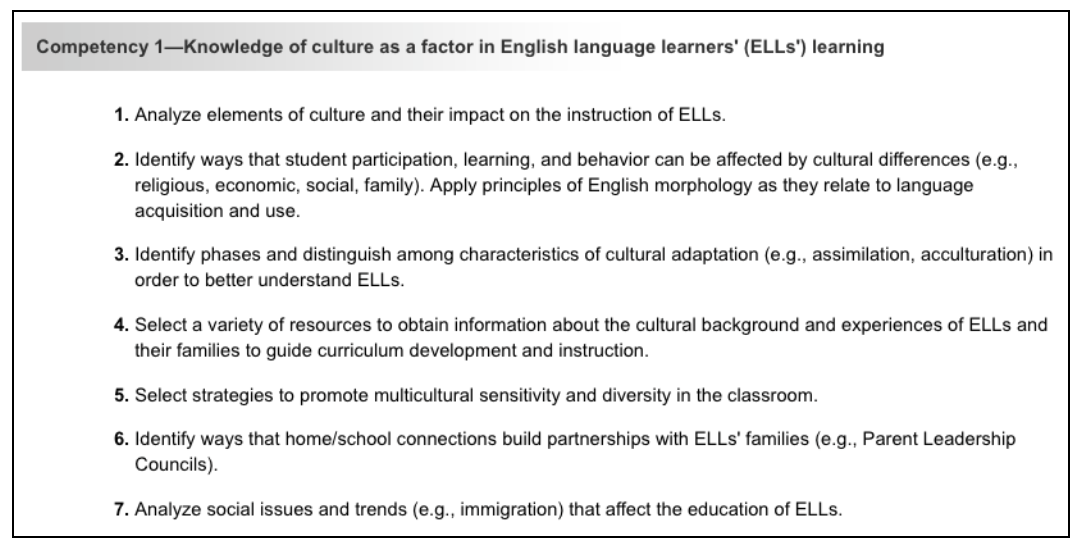
Culture competency questions account for about 8% of the entire test.
Concepts to Know
Let’s take a look at some concepts you definitely need to know for the test.
Assimilation vs. Acculturation
Any student who has moved to a new country will likely go through cultural assimilation/acculturation. Cultural assimilation happens when a person’s culture starts to resemble the dominant culture.
Acculturation occurs when a person adopts some of the dominant culture’s customs, while maintaining their native customs and cultural practices.
Assimilation is not as beneficial as acculturation, because there are great benefits to people maintaining their native culture and language, while also learning a new language and customs.
This process looks different for every student, but typically you can expect an ESOL student, who is new to the United States, to go through four stages:
- Initial or “honeymoon” stage-the student is very excited about their new life. Some try very hard to fit in, while others feel very isolated. Students in this stage may not attempt to speak in English while they are acquiring the language and adjusting to a new culture.
- Uprooting stage-this stage is very difficult for ELLs, because they begin to recognize the differences between their culture and the new culture. The ELL has varying feelings about his/her new surroundings and culture. The student and his/her family feels curious, lonely, and possibly scared.
- Culture shock-this stage can happen at the same time or right after the uprooting stage. In this stage, people may begin to feel overwhelmed from losing familiar places, people, and day-to-day routines from their native culture. Students in this stage may be fearful of their new situation and can show signs of withdrawal, anger, sadness, etc. They may also struggle academically as more is expected of them.
- Adaptation-people begin to accept and become more comfortable in their new culture. Students typically go through either assimilation or acculturation.
-
- Assimilation– the ELL replaces native cultural values with his/her new culture
-
- Acculturation– the ELL adopts some of his/her new culture while he/she maintains native cultural values and customs.
Elements of Culture
Culture is the way of life for groups of people or societies. Culture can be broken into different elements:
- Social organization–how society is organized including family patterns and social classes
- Customs and traditions–behavior that includes the ideas of what is wrong and right
- Religion–answers questions about the meaning of life; can often be a point of conflict when ideals are different; monotheism is the belief in one god, polytheism is the belief in many gods, and atheism is the belief in no god
- Language–language is the foundation of culture; all cultures have a spoken language
- Art and literature–passes on basic beliefs of a culture through music, writing, folk tales, and art; these are the products of a culture’s imagination
- Government–governments provide people’s common needs, keep order, and protect the society; governments hold power in a society and make/enforce laws; common government structures include a democracy (people have the power and the government acts with consent), a republic (the citizens choose leaders), or a dictatorship (a leader comes to power by force using military power or support)
- Economic systems–the way people use their resources to satisfy needs and wants; this includes the type of goods produced, where goods are produced, how goods are produced, and for whom goods are produced
Each of the factors influence ELLs to varying degrees depending on how different the new culture is compared to the native culture. Of course, there will be major differences that can cause the ELL to feel frustrated, unsuccessful, and unmotivated. It is important that teachers have a clear understanding of each element’s role, so they can create a learning environment that is culturally diverse and supports all students.
ESOL Competency: Language as a System
Language as a System competency questions account for about 12% of the entire test.
Concepts to Know
Here are some concepts you definitely need to know for the test.
Universal Principles of Language
The universal principles of language include:
-
- Phonology– the sounds that symbols of a language make, including how they blend and sound individually (phonemic awareness)
- Morphology– understanding morphemes when listening and reading and using them correctly when speaking and writing; a morpheme is a unit of language, such as a prefix or suffix, that cannot be further broken down (un-meaning notor -edturning a word into past tense)
- Syntax-how words can be combined to form sentences in spoken and written language; this includes using and understanding correct sentence structure for all parts of language
- Semantics-the definition or meaning of words in language; this includes vocabulary used when listening, speaking, writing, and reading
- Pragmatics-the appropriate use of language in conversation and social settings; this includes understanding social aspects of language when listening, using language so that it is understood in a certain setting, and understanding the audience’s point of view
- Discourse-communicating by words in conversation; discourse can be formal, such as in an academic setting, or informal, such as a conversation between friends
Structural Ambiguity
Structural ambiguity refers to a sentence that has more than one meaning, not based on the words themselves but how the sentence is structured.
For example:
“That is a five foot man eating snake.” This could mean a five foot tall man is eating a snake, or it could mean that a five foot long snake eats men.
“ The turkey is ready to eat.” This could mean the turkey is hungry and ready to eat, or a turkey has been cooked and is ready to be eaten.
Morphology
Morphology refers to the study of the smallest units of a language that have meaning. Some words are considered morphemes (free morphemes); prefixes and suffixes are also considered morphemes (bound morphemes).
For example:
Boy is a word but also a free morpheme, because it cannot be broken into a meaningful chunk; however, we can add s to boy and make boys. In this case, sis a bound morpheme but not a word.
Write is a morpheme and a word; the prefix and morpheme re-can be added to create the word rewrite.
Here are some common morphemes and their uses:
- -s, -es, -en: to make nouns plural
- -’s: to make nouns possessive
- -s’: to make plural nouns possessive
- -ing or -ed: to change the tense of a verb
- -er and -est: to compare describing words
Morphology should be taught as a strategy for reading comprehension. When using morphology to improve vocabulary and understand words with an unknown meaning, students must learn to:
- recognize a word as unfamiliar
- look for recognizable morphemes in the root of the word, as well as the suffixes
- think of possible meanings based on the parts of the word
- check for meaning in context of the sentence
ESOL Competency: Language Acquisition and Development
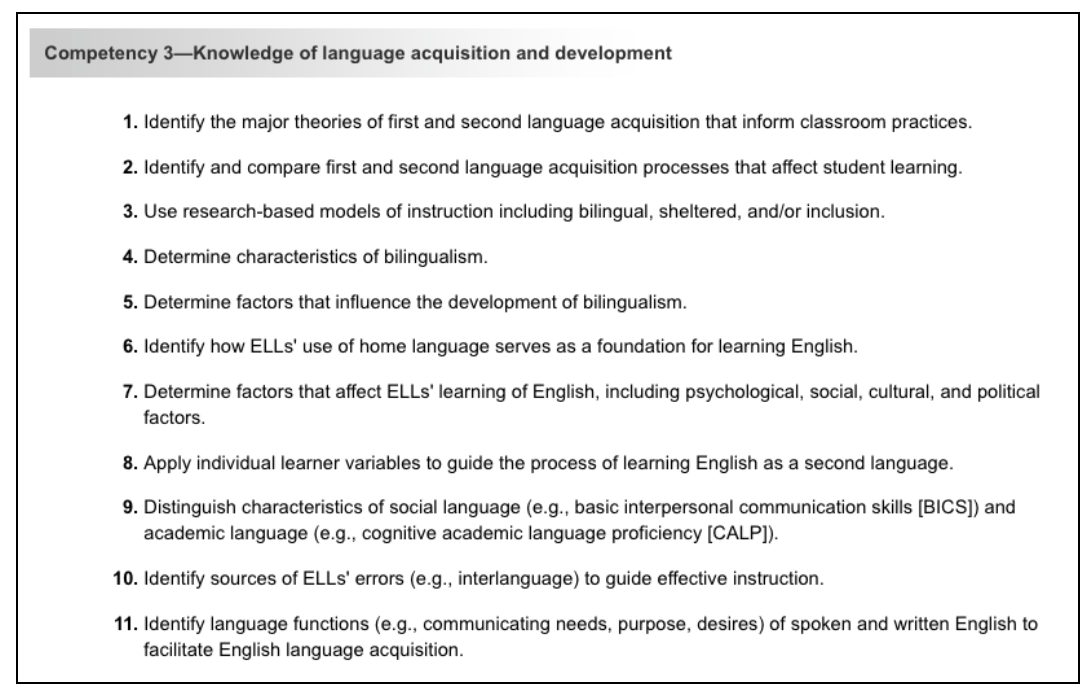
Language Acquisition and Development competency questions account for about 12% of the entire test.
Concepts to Know
Let’s take a look at a few concepts that are likely to appear on the test.
Input Hypothesis
The Input Hypothesis is a concept proposed by linguist Stephen Krashen that says the only way to acquire language is to receive input (instruction) that is just beyond our comfort level but not beyond our understanding. ELLs must also have the right environment for comprehensible input to work, meaning that they need to have low stress and high motivation.
Overgeneralization
Overgeneralization occurs in the earliest stages of language acquisition; this happens when ELLs apply grammar rules to irregular verbs and nouns.
For example:
- Instead of wenta student might say “goed”
- Instead of feeta student might say “foots”
- Instead of fisha student might say “fishes”
- Instead of atea student might say “eated”
Transitional Strategy
The goal behind a transitional bilingual educational strategy is to help transition an ELL to an English-only classroom as soon as possible. Students learn core subjects such as science, language arts, math, and social studies in their native language so that when the transition is made to the English-only classroom, the ELL has the necessary knowledge to succeed with his/her peers. Transitional programs are typically introduced in kindergarten and continue for five to six years. Most skills learned in an ELL’s native language can later be easily transitioned to the second language.
For example, a new student moves to the United States from Mexico. During the early stages of language acquisition, core subjects are taught in Spanish by a bilingual teacher, but as the student’s English skills improve, the bilingual teacher decreases instruction in Spanish and increases instruction in English.
Circumlocution
Circumlocution is a strategy used by ELLs that allow them to describe or define a concept instead of using a specific word.
For example, if a student doesn’t know the word for banana:
What they want to say: “I’d like to eat a banana.”
What they say using circumlocution: “I’d like to eat the fruit that is yellow and that monkeys like to eat.”
Most listeners would understand the speaker is referring to a banana, and the student did not have to stop and look up the word in the dictionary or take a long time to think of the word.
ESOL Competency: Second Language Literacy Development
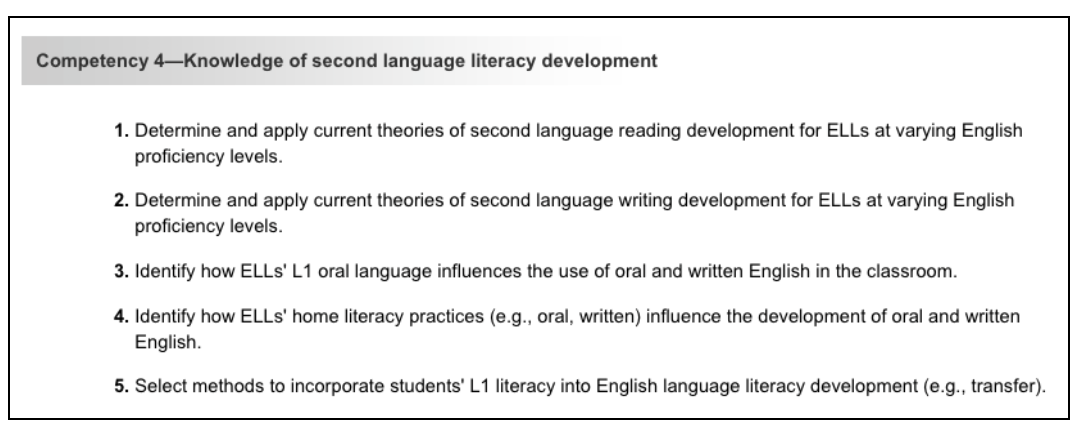
Second Language Literacy Development competency questions account for about 10% of the entire test.
Concepts to Know
Here are some concepts that you may see on the test.
Language Transfer
Language transfer happens when rules from a native language are transferred and applied to a second language.
- Positive transferhappens when the understanding and application of the rule helpslanguage acquisition.
- Negative transferhappens when the understanding and application of the rule hinderslanguage acquisition.
Cognates
Cognates are words that share a similar meaning, spelling, and pronunciation in two different languages.
For example:
The Spanish word informaciónis very similar to the English word information.
For Spanish speaking ELLs, cognates help form a bridge between Spanish and English, especially in subjects such as math and science.
Pseudo-Words
Pseudo-words are combinations of letters and sounds that have no meaning but can be pronounced because they are formed using recognizable blends of phonemes. Beginning readers and ELLs can practice phonemic awareness by decoding pseudowords such as:
- dup
- kam
- vam
- gup
- rin
- tup
- sup
- nup
ESOL Competency: Research, History, Public Policy and Current Practices
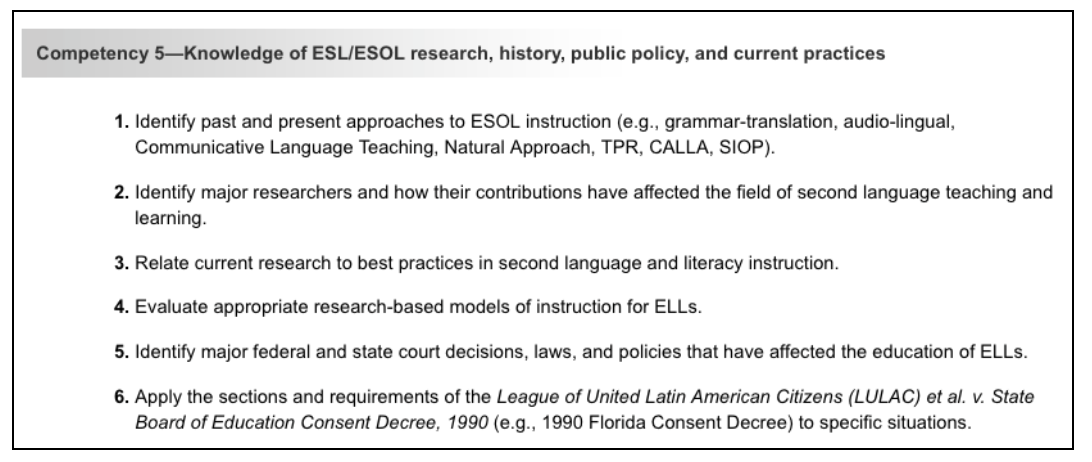
The Research, History, Public Policy, and Current Practices competency questions account for about 5% of the entire test.
Concepts to Know
Let’s look at some concepts that you may see on the test.
SIOP
Sheltered Instruction Observation Protocol (SIOP) was created to help ELLs understand content material. The SIOP model includes eight components:
- Lesson preparation-planning must include lessons that help ELLs make connections between their knowledge and experiences and the new content being presented. Lessons should include learning objectives for content, as well as language, and should be age and educationally appropriate.
- Building background-concepts that are taught must be related to student’s background experiences whenever possible. The connection can be personal, academic, or cultural. Teachers should emphasize key vocabulary in context.
- Comprehensive input-teachers should use vocabulary that is appropriate to the ELL’s level of language proficiency. Teachers need to speak slowly, clearly, and try to use body language, gestures, and applicable pictures when teaching new vocabulary.
- Strategies-processes and methods that help ELLs learn and remember information. Students should be given multiple opportunities to use various strategies that have been taught explicitly.
- Interaction-it is important for ELLs to use English across all content. In this stage of SIOP, students can explore content. Students should be able to practice speaking, asking questions, answering questions, and clarifying ideas. It is important to provide plenty of wait time during this phase.
- Practice and application– lessons should include many opportunities to use hands-on materials to practice content.
- Lesson delivery-this includes how well the learning and language objectives are presented by the teacher.
- Review and assessment-this should be included into daily lessons. Effective sheltered instruction includes reviewing key concepts, providing feedback, and adjusting instruction based on how the ELL responds.
Lau v. Nichols
Lau v. Nichols (1974) references a US Supreme Court case which ruled that the lack of second language instruction in public schools for ELLs violated the Civil Rights Act of 1964. The suit was filed by Chinese parents in San Francisco. The ruling stated that “identical does not constitute equal education” and that school districts must take steps to help LEP students overcome educational barriers.
The biggest impact of Lau v. Nichols was that school districts across the country adopted bilingual education programs to better serve LEP students, and more safeguards are now provided to make sure students with limited English proficiency are as successful as possible.
Inclusion Model
The inclusion model of ESL instruction places an ESL specialist in the general education classroom, rather than pulling ESL students out of the classroom. The ESL specialist provides specific support to ELLs by modifying lessons, displaying pictures to go along with vocabulary, and providing other comprehension aids.
ESOL Competency: Standards-Based ESOL and Content Instruction
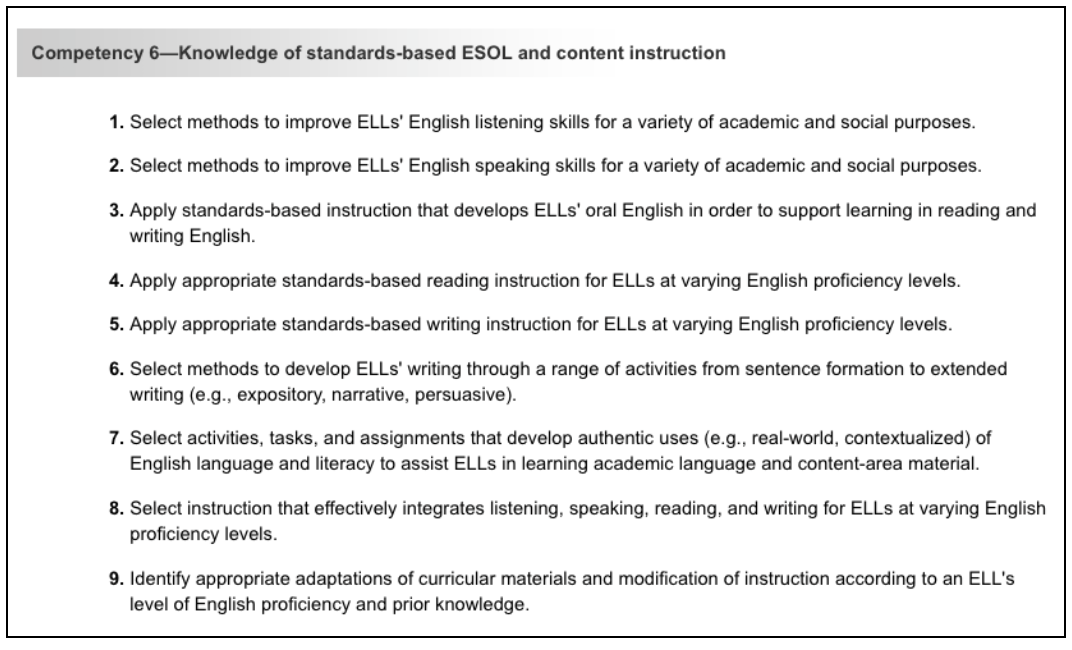
Standards-Based ESOL and Content Instruction competency questions account for about 14% of the entire test.
Concepts to Know
Here are some concepts that you may see on the test.
Expository Writing
Expository writing is non-fiction writing that typically presents reasons, steps in a process, or explanations.
Teachers can support ELLs in expository writing by:
- teaching skills in nonfiction reading and writing first
- spending plenty of time in the prewriting stage
- using graphic organizers to organize information (use sentences rather than phrases)
- not expecting ELLs to self-edit
- modeling good writing at the ELL’s language level
Methods to Improve ELLs’ Listening Skills
To improve ELLs’ listening skills, students should practice:
- Predicting content– watch or listen to a video and pause occasionally to let students predict what is going to happen.
- Listening for gist– watch a video with students and let them predict what the content will be (based on the title). Instruct students to listen for content words during the video. Then, re-watch the video using subtitles and discuss what was understood the first time.
- Detecting signpost words– teach students to recognize signpost words and phrases such as, first of all, in summary, to illustrate, for example, etc. Signpost words help ELLs link ideas and understand the direction of a topic or conversation.
- Listening for details-give students the opportunity to listen for specific information in content. For example, listen to a news report about sports, and ask students to list details about specific stats or scores.
Adapting Curriculum
Teachers can adapt curriculum and instruction using various methods so that ELLs receive the appropriate amount of support. Common methods to adapt curriculum include:
- providing a copy of notes when presenting vocabulary
- showing students how to create flashcards and study materials for weekly quizzes
- allowing ELLs to listen to material instead of reading it independently
- allowing ELLs extra time to complete assignments
- breaking instructions down into very small steps
- using music to help with understanding vocabulary
- using frequent positive reinforcement
- encouraging students to use spelling words in sentences or stories
ESOL Competency: Resources and Technologies
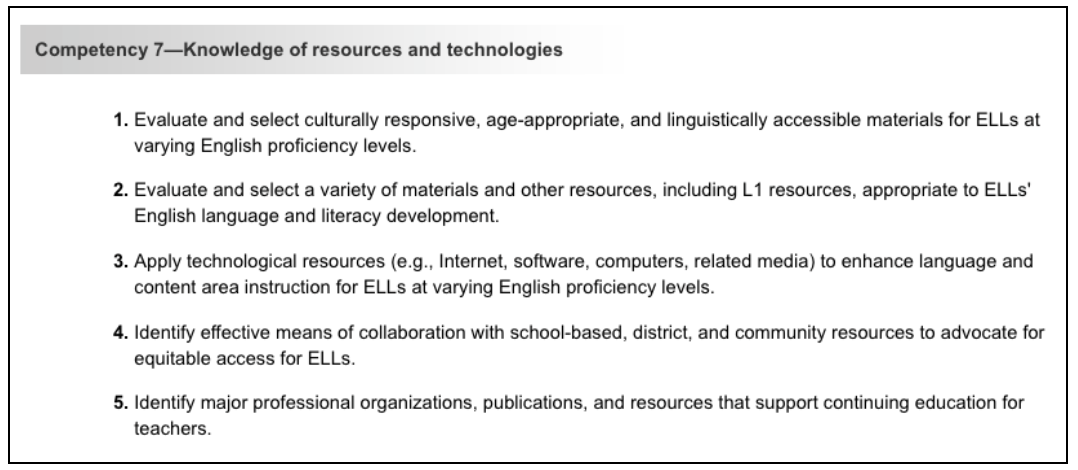
Resources and Technologies competency questions account for about 8% of the entire test.
Concepts to Know
Let’s take a look at some concepts that may appear on the test.
Multicultural Texts
Multicultural texts describe how people live throughout the world. It can be a powerful tool in the classroom that not only helps students understand other cultures, but also their own. Many times, multicultural texts will feature themes that involve family, traditions, holidays, religion, and preserving culture. Reading multicultural texts also helps students become more sensitive and aware of the challenges other cultures might face; it also helps them have a more diverse perspective of the world around them.
When selecting multicultural books for the classroom, teachers should consider:
- General accuracy– is the book relevant and accurate?
- Stereotypes– the book should reflect characteristics about a specific character’s story, not necessarily specific traits blindly applied to an entire group of people.
- Setting-books should be accurate in their settings, making sure to not reinforce stereotypes. For example, not all Native Americans lived in tepees, but some books might depict that.
- Language– books that have multiple languages in them should use the actual languages. Any words that are translated should be natural and not awkward.
- Illustrations-book illustrations should represent that people, even within the same culture, do not all look alike.
- Author’s perspective-you should consider if the author is a part of the culture depicted or if they are writing from an outsider’s perspective.
Collaborative Webquests
Collaborative Webquests offer internet-based language learning to ELLs. Webquests provide ELLs the opportunity to read authentic material, as well as discuss content in a meaningful way.
Collaborative webquests:
- focus on an interesting task that is a smaller scale version of what an adult would do as an employee or member or society
- require higher order thinking, not just summarizing. Students can be required to analyze, problem solve, create, and judge.
- use academic resources on the internet.
- ARE NOT a simple research report or step-by-step procedure.
- typically have five parts:
- an introduction
- the task
- the process
- the evaluation
- a conclusion
Webquests are also a great way for ELLs to collaborate in English with other students. ESL teachers can use Webquests across curriculum as a strategy to enhance instruction because they provide authentic learning opportunities in the targeted language (English).
ESOL Competency: Planning Standards-Based Instruction
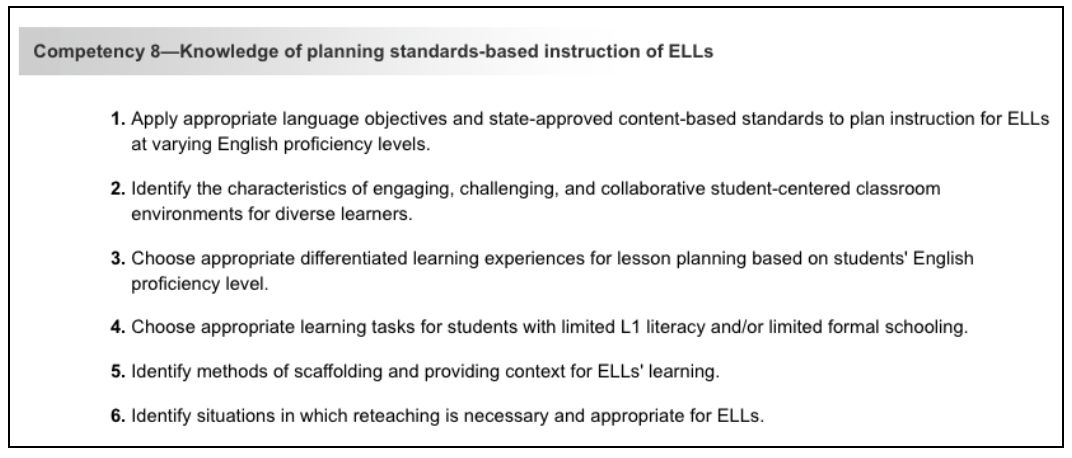
Planning Standards-Based Instruction competency questions account for about 10% of the entire test.
Concepts to Know
Here are a few concepts that may appear on the actual test.
Student-Centered Classroom Environment
A student-centered classroom focuses on the individual interests and needs of every student. Characteristics of student-centered classrooms include:
- collaborative work spaces
- assessments that use open-ended questioning
Student-centered classrooms also:
- value student engagement over convenience
- honor student passions and interests
- allow opportunities for student input
- nurture and encourage positive and healthy relationships
Student-centered classrooms support ELLs, because each student’s needs are considered and every effort is made to support those needs. Student-centered classrooms also provide LEP students with opportunities to collaborate with peers which builds language skills and confidence.
Scaffolding
Scaffolding is a type of differentiation that meets students where they’re at academically and requires them to work just above their independent level. Teachers support students by helping them make connections and build on prior knowledge. This method provides ELLs the structure and support they need to feel comfortable while learning, but also forces them to take risks that result in higher level thinking and learning. Effective scaffolding includes:
- modeling/think-alouds
- tapping into prior knowledge
- giving students time to talk and process new ideas/concepts
- pre-teaching vocabulary
- using visual aids
- providing “think time” and reviewing
ESOL Competency: Assessment Issues
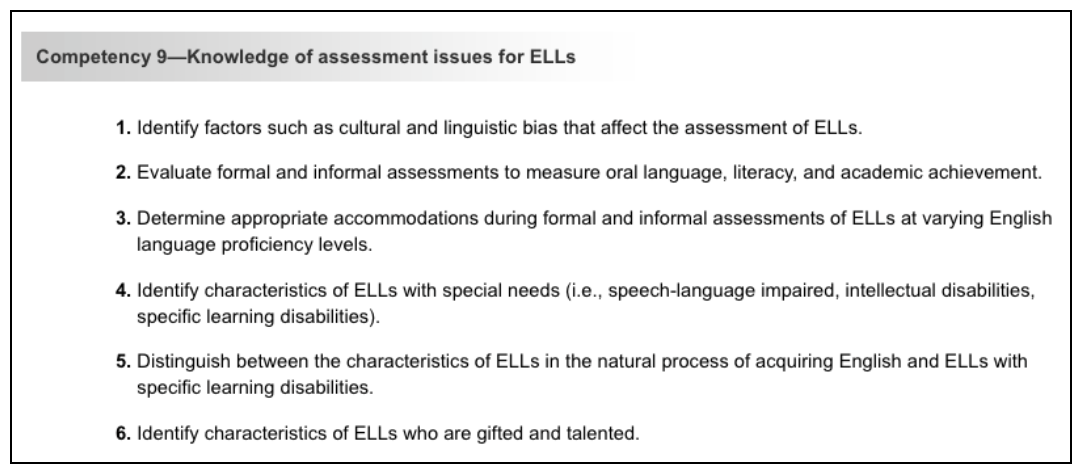
Assessment Issues competency questions account for about 8% of the entire test.
Concepts to Know
Let’s take a look at some concepts that may appear on the test.
Cultural and Linguistic Bias
- Cultural bias-the event of judging or interpreting information by standards associated with one’s native culture.
Cultural bias can influence a teacher’s instruction, attitude, and behavioral expectations.
For example, a test question asked African American students to infer where a man, who was standing on a corner in a suit, was going. The test writers, who were caucasian, agreed the correct answer was “work.” However, the majority of African American students thought that the man was probably going to church (Perry and Delpit, 1998).
- Linguistic bias-at all levels of education, teachers will many times favor students who sound like themselves and can be biased against students who speak a different language. This bias can potentially affect how a teacher talks to a student and the expectations the teacher has for the student; it can even cause a teacher to stereotype or discriminate against a student.
For example, when creating an assessment, teachers should only include vocabulary and language that was used/taught in class. Including idioms or phrases that are probably only familiar to native speakers will not be a fair assessment for ELLs.
ESE Services
In Florida, students who require specially designed instruction and/or related services are called exceptional students. The services these students receive are called exceptional student educationor ESE services.
The following are eligible conditions for ESE services:
- autism
- deaf or hard-of-hearing
- deaf/blind
- emotional or behavioral disabilities
- gifted
- homebound or hospitalized
- intellectual disability
- language impairment
- other health impairment
- orthopedic impairment
- specific learning disability
- traumatic brain injury
- visual impairment
A team of people make decisions about the ESE services a student will receive. A student must meet eligibility requirements to receive ESE services, and the referral process, which is based on the Individuals with Disabilities Education Act, includes:
- A referral request for a formal review is made. This includes detailed information about the student’s learning needs, strengths, weaknesses, health information, and interests.
- The team determines whether or not additional evaluation is required to determine eligibility.
- If additional evaluation is recommended, the evaluation moves forward with interviewing teachers and parents. Diagnostic assessments are given by specialists which could include interventionists, diagnosticians, and/or psychologists. Parents must sign a consent form before evaluation can begin.
- If it is determined that a student meets eligibility requirements, the team (including the parents) meet to discuss what services will best fit the needs of the student.
Formal versus Informal Assessments
Formal and informal assessments are important tools throughout the learning process.
Formal assessments
(summative assessments) should take place after many opportunities for learning/practice and can include:
- standardized tests
- data that is compared
- structured testing environments
Informal assessments
(formative assessments) should take place throughout the learning process, and instruction should be adjusted based on the results of the informal assessment. Informal assessments can include:
- non-standardized tests
- observation and interviews
- normal classroom environments
- no data taken
ESOL Competency: Language Proficiency Assessment

Language Proficiency Assessment competency questions account for about 5% of the entire test.
Concepts to Know
Let’s take a look at a concept that may appear on the test.
Communicating with Stakeholders
A stakeholder, in terms of education, is any person who has an interest in the education process of a particular school, classroom, or student. Positive relationships have a huge impact on academic success, so communication should be a top priority. To positively communicate with stakeholders, educators should:
- Create two-way communication
This can be done using technology like communication apps, email, blogs, websites, or social media pages created for the classroom.
- Be a leader when communicating
Communication on social media, websites, or blogs should portray a positive picture of the things going on in your classroom and at your school.
- Align your actions with your words
It is important that you are promoting what is actually happening at your school and in your classroom. If you are promoting growth and high scores, reports to stakeholders should reflect that.
ESOL Competency: Classroom-Based Assessment
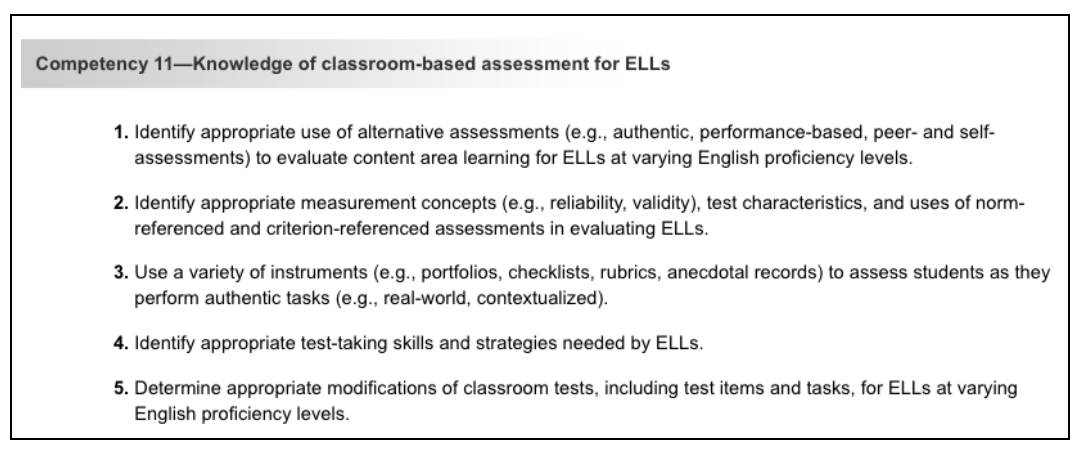
Classroom-Based Assessment competency questions account for about 8% of the entire test.
Concepts to Know
Let’s take a look at some concepts that may appear on the test.
Norm- versus Criterion-Referenced Assessments
Norm-referenced assessments
compare a student’s performance with that of his/her peers. Norm-referenced assessments are scored in percentiles, not by a standard score or pass/fail status.
For example, if a fifth grader takes a norm-referenced reading assessment, the student’s score will be compared to the scores of his/her peers on the same test. The student will be placed into a quintile group, or percentile, based on how the student’s score compares to the rest of the students who took that test.
Criterion-referenced assessments
measure mastery of specific learning objectives based on a scale score. The score is then used to determine if the student did or did not master the learning objective. Criterion-referenced assessments typically assign pass/fail or met standard/did not meet standard designations to the results.
For example, students complete a unit over multiplying decimals. The teacher gives all students the same 10 questions, and students must answer 8 out of 10 questions correct in order to meet standard or demonstrate mastery.
Performance-Based Assessments
Performance-based assessments are an alternative to traditional multiple-choice assessments. Performance-based assessments measure students’ mastery of a skill and/or knowledge through a task-oriented project or question.
Instead of using a multiple-choice test to check for mastery, teachers can ask students to:
- create a presentation
- design a portfolio
- perform a short play
- complete a project
- participate in an exhibition or fair
- participate in a debate over the topic
Self-Monitoring Checklist
A self-monitoring checklist allows students to monitor their own behavior in an effort to improve social skills, as well as increase success in the learning environment. When developing a self-monitoring checklist for students, teachers should:
- identify the behavior that needs to be improved upon or monitored
- create an appropriate checklist
- choose a schedule for self-monitoring
- decide on a monitoring cue
- choose a reward for successful behavior
- phase out the checklist as the behavior improves
Self-monitoring is important for students because checklists:
- promote responsibility
- promote independence
- improve coping skills
- increase productivity
- improve self-awareness
- increase self-esteem
And that is some basic information about the FTCE ESOL exam.
